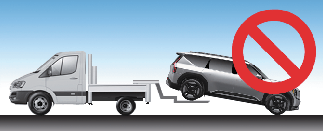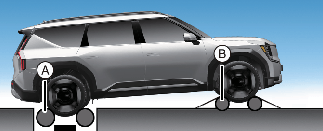For safe AWD operation
Before driving
-
Make sure all passengers are wearing seat belts.
-
Sit upright and closer to the steering wheel than usual. Adjust the steering wheel to a position comfortable for you to drive.
Driving on snow-covered or icy roads
-
Start off slowly by applying the accelerator pedal gently.
-
Use snow tires.
-
Keep sufficient distance between your vehicle and the vehicle in front of you.
-
Using the regenerative braking helps the steering on the downhill. However it is difficult to adjust the vehicle while coasting, so avoid using the third level of regenerative braking as much as possible.
-
Avoid speeding, rapid acceleration, sudden brake applications, and sharp turns to prevent skids.
-
It is difficult to start again if the vehicle stops on an uphill road. Keep your distance from other vehicles and drive slowly.
Driving in sand or mud
-
Maintain a slow, constant speed.
-
Keep sufficient distance between your vehicle and the vehicle in front of you.
-
Reduce vehicle speed and always check the road condition.
-
Avoid speeding, rapid acceleration, sudden brake applications, and sharp turns to prevent getting stuck.
Driving up or down hills
-
Driving uphill
-
Before starting off, check if it is possible to drive uphill.
-
Drive as straight as possible.
-
-
Driving downhill
-
Do not change gear while driving downhill. Select gear before driving downhill.
-
Drive straight as possible.
-
Driving through water
-
Try to avoid driving in deep standing water.
-
Do not change gear while driving in water.
Additional driving conditions
-
Become familiar with the off-road conditions before driving.
-
Always pay attention when driving off-road and avoid dangerous areas.
-
Drive slowly when driving in heavy wind.
-
Reduce vehicle speed when cornering. The center of gravity of AWD vehicles is higher than conventional 2WD vehicles, making them more likely to roll over when you rapidly turn corners.
-
Always hold the steering wheel firmly when you are driving off-road.

-
If the AWD warning light (
 ) stays on the instrument cluster, your vehicle may have a malfunction with the AWD system. When the AWD warning light (
) stays on the instrument cluster, your vehicle may have a malfunction with the AWD system. When the AWD warning light ( ) appears, have your vehicle checked by an authorized Kia dealer.
) appears, have your vehicle checked by an authorized Kia dealer.
-
Do not drive in conditions that exceed the vehicles intended design such as challenging off-road conditions.
-
Avoid high speeds when cornering or turning.
-
Do not make quick steering wheel movements, such as sharp lane changes or fast, sharp turns.
-
The risk of a rollover is greatly increased if you lose control of your vehicle at highway speeds.
-
Loss of control often occurs if two or more wheels drop off the roadway and the driver over steers to reenter the roadway.
-
In the event your vehicle leaves the roadway, do not steer sharply. Instead, slow down before pulling back into the travel lanes.
-
Exercise extreme caution when driving up or down steep hills. The vehicle may flip depending on the grade, terrain and water/mud conditions.
-
Do not grab the inside of the steering wheel when you are driving off-road. You may hurt your arm by a sudden steering maneuver or from steering wheel rebound due to an impact with objects on the ground. You could lose control of the steering wheel which may lead to serious injury or death.

Always drive slowly in water. If you drive too fast, water may get into the motor compartment, causing your vehicle to suddenly stop.

-
Do not drive in water if the level is higher than the center of the wheel.
-
Check your brake condition once you are out of mud or water. Depress the brake pedal several times as you move slowly until you feel normal braking return.
-
Shorten your scheduled maintenance interval if you drive in off-road conditions such as sand, mud or water (refer to More Details.)
-
Make sure that AWD vehicle is towed by a flatbed tow truck.
-
AWD vehicles could change the engagement status of the motor according to the situation required. Auto changing the driving mode (2WD/AWD) helps improve energy efficiency and driving stability.
-
When the vehicle is stuck in snow, sand or mud, place a non-slip material under the drive wheels to provide traction OR slowly spin the wheels in forward and reverse directions which causes a rocking motion that may free the vehicle.
-
If tire chains must be used, use fabric snow chain and install the tire chain after reviewing the instructions provided with the tire chains. For more information on Snow Tires and Tire Chains, refer to More Details.
Tire precautions
Always check the condition of the tires for AWD vehicles.
When driving in, driving force is applied to all tires, and the driving performance of the vehicle is greatly affected by the degree of tire wear:
-
When replacing tires, be sure to equip all four tires with the same size, type, tread, brand and load-carrying capacity. Do not install tires and wheels with different sizes and types from the ones originally installed on your vehicle. This can affect the safety and performance of your vehicle which could lead to steering failure or rollover causing serious injury or death..
-
Rotate the front and rear tires every 6,000 miles (10,000 km).
-
Each tire should be checked monthly when cold and inflated to inflation pressure recommended by the vehicle manufacturer on the vehicle placard or tire inflation pressure label.
-
If tire chains must be used, only use fabric snow chains and install the chains after following the instructions provided with the tire chains.
Towing precautions


The AWD vehicle should never be towed with wheels on the ground. It must be towed with a wheel lift and dollies or flatbed equipment with all the wheels off the ground.
* Refer to More Details.

The AWD vehicle cannot be towed with sling-type equipment. Use wheel lift or flatbed equipment.

Your vehicle is equipped with tires designed to provide safe ride and handling capability. Do not use tires and wheels that are different in size and type from the originally installed ones. This can affect the safety and performance of your vehicle, which could lead to steering failure or rollover and serious injury. When replacing the tires, be sure to equip all four tires with tires and wheels of the same size, type, tread, brand and load-carrying capacity.

Jacked vehicle
When full-time AWD vehicle is being raised on a jack, never start the motor or cause the tires to rotate.
There is the danger that rotating tires touching the ground could cause the vehicle to come off the jack and jump forward.
-
Full-time AWD vehicles must be tested on a special four-wheel chassis dynamometer.
 NOTICE
NOTICENever engage the parking brake while performing these tests.
-
If a 2WD roll tester must be used, perform the following procedure.

[A]: Roll tester (Speedometer)
[B]: Temporary free roller
-
Check tire pressure recommended for your vehicle.
-
Place the rear wheels on the roll tester for a speedometer test as shown in the illustration.
-
Release the parking brake.
-
Place the front wheels on the temporary free roller as shown in the illustration.

Dynamometer testing
Keep away from the front of the vehicle when the vehicle is in gear on a dynamometer. This is very dangerous as the vehicle can jump forward and cause serious injury or death.

-
When lifting the vehicle, do not operate front and rear wheels separately. All four wheels should be operated.
-
If you need to operate the front and rear wheels when lifting the vehicle, release the parking brake.